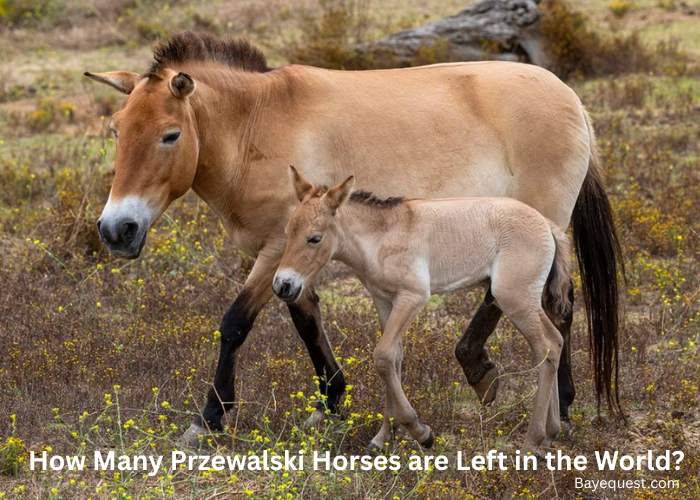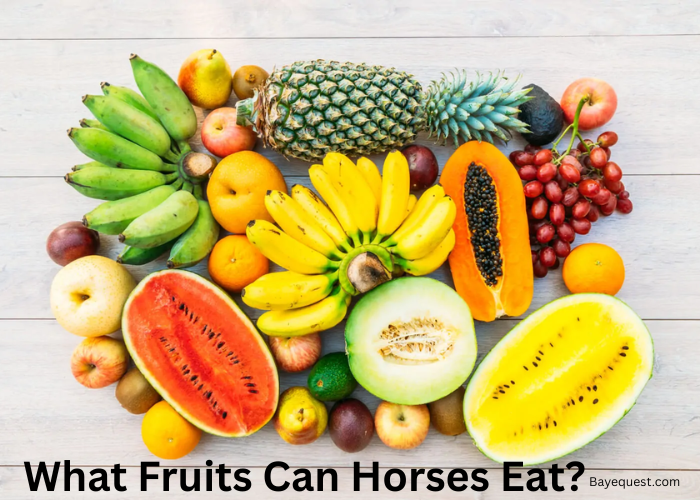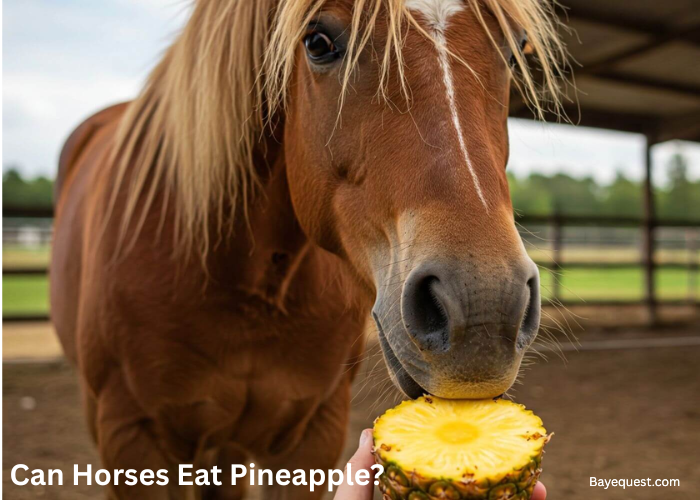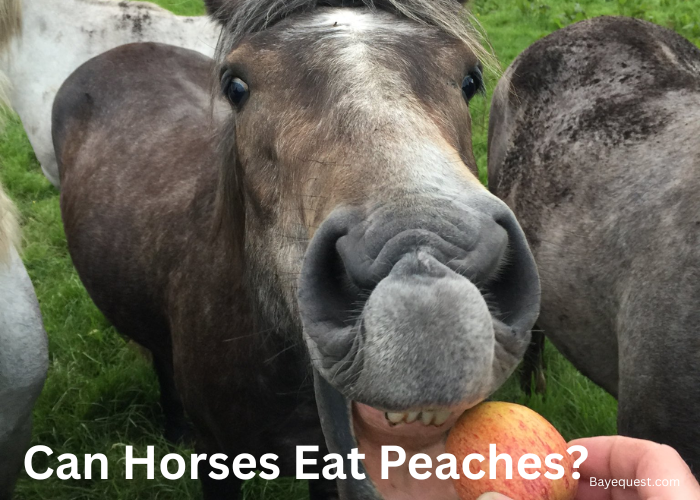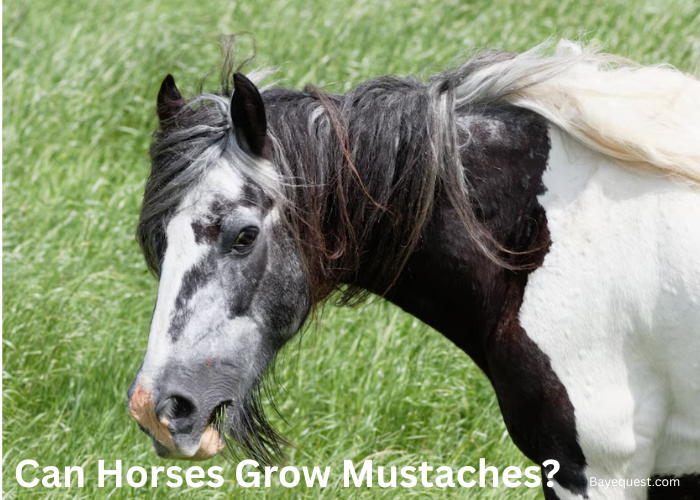Among all the horse species on Earth, none carries as much mystery and significance as the Przewalski’s horse. At one point in the 20th century, the species vanished entirely from the wild, with only a handful surviving in captivity.
Many believed they would be lost forever. Yet today, thanks to determined conservationists, zoos, and reintroduction programs, the Przewalski’s horse is making a slow but steady comeback.
This article explores what it took to bring them back from the brink of extinction and answers the common question: just how many Przewalski horses are left in the world?
How Many Przewalski Horses are Left in the World? Key Takeaway
Today, there are roughly 2,000 Przewalski horses worldwide, including wild herds in Mongolia and China as well as captive populations in zoos and reserves. While this represents a remarkable recovery from near-extinction, the species remains endangered and continues to rely on ongoing conservation, habitat protection, and careful genetic management to secure its future.
What is a Przewalski’s Horse?
The Przewalski’s horse (Equus ferus przewalskii), sometimes called the Mongolian wild horse or “takhi,” is the world’s last surviving species of truly wild horses.
Unlike feral horses, such as mustangs in North America or brumbies in Australia, which are descendants of domesticated horses that returned to the wild, Przewalski’s horses have never been tamed or selectively bred by humans.
This makes them a living link to the prehistoric past of equines.
Physically, Przewalski’s horses stand out with their stocky build, short legs, and thick necks. They are generally smaller than most domestic horses, averaging about 12 to 14 hands (48 to 56 inches) in height.
Their coats are usually dun-colored with a pale belly, and they feature a short, upright mane without a forelock. Distinct dark stripes run down the backs and legs, giving them a primitive appearance that connects them to their ancient ancestors.
Beyond their looks, these horses also differ genetically from domestic horses. Przewalski’s horses carry 66 chromosomes, two more than domestic horses, which have 64.
Despite this difference, the two species can interbreed and produce fertile offspring, though conservation programs avoid such crosses to maintain genetic purity.
The species owes its name to Russian explorer Nikolai Przewalski, who first described the horse in the late 19th century after learning about it from Mongolian locals.
However, the horses had long been known to the people of Central Asia, who revered them as symbols of the untamed steppe.
Today, they remain a point of cultural pride in Mongolia, where many reintroduction efforts have taken place.
In a nutshell, the Przewalski’s horse is more than just a rare equine. It is a survivor and the oldest horse breed.
Its unique physical and genetic traits, coupled with its ancient lineage, make it an irreplaceable part of the natural world and a living reminder of what truly wild horses once looked like.

Why Did Przewalski’s Horses Nearly Go Extinct?
The decline of the Przewalski horse was not caused by a single event, but a combination of pressures that mounted over time.
Habitat loss and competition with livestock
Mongolia and northern China, the native range of the Przewalski’s horse, have long been grazing lands for domestic horses, cattle, sheep, and goats.
Unfortunately, as human herding expanded, the open grasslands that once supported wild horse herds became fragmented and overgrazed.
Przewalski’s horses, which depend on large areas of continuous pasture, were pushed into smaller and less favorable habitats.
Harsh winters and environmental pressures
The climate of the Central Asian steppe is notoriously harsh, with extreme temperature swings and prolonged winters. Severe winters, known locally as dzuds, can wipe out large numbers of grazing animals in a single season.
Starvation during the harsh weather became a recurring threat, especially as the Przewalski’s habitat shrank and food sources dwindled.
Hunting and capture by humans
By the 19th and early 20th centuries, Przewalski’s horses were increasingly hunted for meat and hides. Others were captured alive and shipped to European zoos and private collections.
While these captures helped preserve the species in captivity, they also reduced the wild population dramatically.
Small population and genetic bottlenecks
As numbers fell, the species faced the dangers of a shrinking gene pool. By the 1960s, the entire population could be traced back to fewer than 15 individuals.
Such a severe genetic bottleneck meant reduced diversity, higher risks of inbreeding, and greater vulnerability to disease and infertility.
Complete disappearance from the wild
The final blow came when the last confirmed sighting of a wild Przewalski’s horse occurred in 1969. At that point, the species survived only in captivity.
What remained was a fragile thread of existence – a few small herds scattered across zoos in Europe and Asia. Without coordinated global action, the Przewalski horse was on the verge of becoming a memory.
Conservation Efforts that Saved the Przewalski Species
The Przewalski horse’s redemption was the result of decades of international cooperation, careful breeding management, and bold reintroduction programs.
Captive breeding as the foundation of survival
When Przewalski’s horses disappeared from the wild in 1969, only a handful survived in zoos across Europe and Asia.
At one stage, the entire global population could be traced back to just 12–15 founder horses. Such a narrow genetic base was extremely risky, but it was also the only chance the species had.
Zoos recognized the urgency and began working together to carefully pair horses to maximize genetic diversity.
International cooperation and genetic management
One of the key reasons Przewalski’s horses survived was the unprecedented cooperation between conservationists worldwide.
Zoos exchanged animals, often moving them across continents, to strengthen breeding lines. By the 1970s and 1980s, studbooks and scientific management allowed conservationists to map out the genetic relationships of the global population.
This approach meant that every foal born was part of a long-term strategy, not just an isolated success.
In recent decades, advanced techniques such as artificial insemination, semen freezing, and embryo transfer have been introduced to further secure the species’ genetic future.
Reintroduction to the wild in Mongolia
Perhaps the most remarkable achievement in Przewalski’s horse conservation has been their return to the wild. Starting in the early 1990s, captive-bred horses were transported back to Mongolia, the heart of their ancestral range.
The first large-scale releases took place in Hustai National Park and the Great Gobi B Strictly Protected Area.
Over time, the reintroduced herds adapted to the challenges of the steppe – harsh winters, predation risks, and competition for resources. Today, these herds are self-sustaining, with foals born in the wild contributing to natural population growth.
Smaller reintroduction sites were later established in Khomiin Tal and elsewhere in Mongolia, giving the species a stronger foothold in its native land.
Expansion beyond Mongolia
While Mongolia remains the stronghold of the Przewalski’s horse, reintroduction projects have also been attempted in other regions.
In China, reserves in Xinjiang and Gansu provinces now host small but stable herds. Similarly, in Kazakhstan and Ukraine, limited reintroductions have been carried out as part of broader steppe restoration projects.
These populations are still modest compared to Mongolia’s, but they help spread risk and create new opportunities for long-term survival.
The role of zoos and wildlife parks today
Even with wild herds re-established, captive populations remain essential. More than 1,000 Przewalski’s horses live in zoos, safari parks, and specialized breeding centers around the world.
These facilities act as genetic reservoirs, ensuring that the species will not collapse if wild herds face unexpected threats.
The Association for the Conservation of Przewalski’s Horse continues to coordinate global efforts, overseeing transfers, monitoring genetics, and guiding breeding strategies.
Many zoos also contribute financially to in-situ projects, funding habitat protection, veterinary care, and monitoring programs in Mongolia and beyond.

How Many Przewalski Horses are Left in the World Today?
As of 2025, it is estimated that there are around 2,000 Przewalski’s horses worldwide. This includes both those living in protected reserves and national parks, as well as those kept in captive breeding centers and zoos.
The largest populations can be found back in the wilds of Mongolia. Reintroduction projects, particularly in Hustai National Park and the Great Gobi B Strictly Protected Area, have been successful in establishing free-ranging herds.
These horses are fully self-sustaining, surviving harsh winters and the challenges of the steppe without human aid.
Smaller groups have also been released in Khomiin Tal and other regions of Mongolia, strengthening the species’ foothold in its native range.
Altogether, Mongolia is now home to several hundred wild Przewalski’s horses, a remarkable comeback considering they had once vanished from the landscape.
Beyond Mongolia, reintroduction has extended to China, where small herds roam reserves in Xinjiang and Gansu provinces. Other limited releases have taken place in Kazakhstan and Ukraine, though these populations remain small compared to those in Mongolia.
These projects serve both conservation and scientific purposes, providing valuable insight into how the species adapts to different steppe environments.
Captive populations continue to play a crucial role, too. Over 1,000 Przewalski’s horses live in zoos and wildlife parks worldwide, where they are managed through coordinated breeding programs.
This ensures genetic diversity is preserved, as all living horses can trace their ancestry back to that small group of founders.
Institutions such as the Prague Zoo and the Association for the Conservation of Przewalski’s Horse remain central in coordinating global studbooks and transfers between facilities.
Despite this progress, the species is not out of danger. The International Union for Conservation of Nature (IUCN) currently lists the Przewalski horse as Endangered.
While the population has grown substantially, it is still small enough to be vulnerable to disease outbreaks, climate extremes, and habitat pressure from livestock. In other words, while the numbers are cause for celebration, continued vigilance is essential.
Nevertheless, the journey from fewer than 50 individuals in captivity to over 2,000 across the globe is one of the most inspiring success stories in wildlife conservation.
Today, when we ask how many Przewalski horses are left in the world, the answer is one of hope: thousands now roam where none once stood, proving that extinction can be reversed with determination and cooperation.
Where Can You See Przewalski Horses Today?
For many horse lovers, seeing a Przewalski’s horse in person is a once-in-a-lifetime experience.
Fortunately, thanks to decades of conservation work, opportunities now exist both in the wild and in carefully managed reserves and zoos around the world.
The following are some of the best places to visit if you’d like to see a Przewalski horse.
Mongolia – The heartland of the wild horse
The most authentic way to see Przewalski’s horses is by visiting Mongolia, their ancestral homeland.
The best-known site is Hustai National Park, located just west of the capital, Ulaanbaatar. Here, visitors can join guided tours and witness free-ranging herds roaming the rolling steppe.
Another prime destination is the Great Gobi B Strictly Protected Area, a remote reserve where herds have thrived since their reintroduction in the 1990s.
For those seeking a more off-the-beaten-path adventure, Khomiin Tal offers another chance to see these horses in their natural element.
China – Reserves on the edge of the desert
China has reintroduced small groups of Przewalski’s horses in reserves across Xinjiang and Gansu provinces.
These sites are less visited than Mongolia’s, but they provide unique opportunities to see the species in a semi-wild environment.
Even better, eco-tourism programs in these regions give visitors a way to support Przewalski horse conservation efforts.
Zoos and wildlife parks worldwide
If international travel isn’t an option, Przewalski’s horses can be seen in many zoos and safari parks across Europe, North America, and Asia.
Institutions such as the Prague Zoo, which has been central to the species’ conservation, maintain breeding herds that visitors can observe up close.
Meanwhile, in the United States, facilities like the Smithsonian Conservation Biology Institute in Virginia and several accredited zoos also house these rare horses.
While these animals are not truly wild, seeing them in person helps raise awareness about their fragile status and ongoing recovery.
Eco-tourism and conservation support
For travelers who wish to do more than just observe, eco-tourism programs in Mongolia and China offer ways to support conservation directly.
Guided tours often contribute funds to habitat protection and monitoring programs. Visitors not only experience the beauty of the steppe but also play a small role in ensuring the horses’ continued survival.

Challenges Still Facing Przewalski Horses
The survival of the Przewalski’s horse is one of conservation’s great success stories, but the journey is far from over. With only around 2,000 individuals alive today, the species remains vulnerable.
Several challenges threaten its long-term future, and without continued effort, the progress made could quickly unravel. The biggest challenges include;
Small population size and genetic risks
Although numbers have increased dramatically, the species’ entire genetic pool still comes from fewer than 15 founders.
This narrow base leaves them vulnerable to inbreeding, reduced fertility, and genetic disorders. Scientists are working overtime to manage breeding, but the risk of losing vital diversity remains a constant concern.
Harsh winters and climate change
The Mongolian steppe is unforgiving. Severe winters can wipe out wild animals in large numbers, especially when snow and ice cover grazing areas. Climate change may make such events more frequent and unpredictable.
At the same time, droughts threaten water and food availability, adding more stress to wild herds.
Competition with domestic livestock
Mongolia’s human population depends heavily on herding livestock such as goats, sheep, and horses. As herds expand, they compete directly with Przewalski’s horses for grassland and water.
Overgrazing reduces food availability, and in some areas, domestic animals push wild horses into marginal habitats.
Disease transmission
Sharing land with domestic horses also raises another danger: disease. Illnesses that are mild in domestic animals can devastate wild herds, which lack immunity.
Therefore, the close proximity between the two species makes disease monitoring and veterinary interventions critical.
Dependence on ongoing human support
Unlike truly secure species, Przewalski’s horses cannot yet survive without human help. Captive breeding, genetic management, and habitat protection require funding and coordination.
A lapse in global commitment could easily reverse the progress of the past decades.
How Many Przewalski’s Horses Are Left in the World? Conclusion
The Przewalski’s horse is more than a rare species; it is a symbol of survival against overwhelming odds.
From disappearing entirely from the wild to a global population of around 2,000 today, these horses remind us that dedicated conservation efforts can reverse even the most dire situations.
The next chapters of its story will depend on whether humans continue to value and protect this rare reminder of our planet’s wild heritage.




